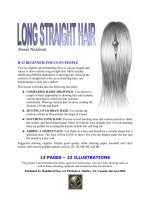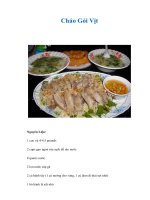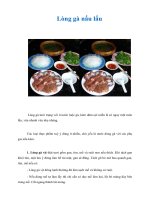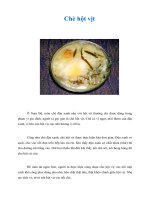Tài liệu Long Straight Hair docx
Bạn đang xem bản rút gọn của tài liệu. Xem và tải ngay bản đầy đủ của tài liệu tại đây (1.96 MB, 13 trang )
Brenda Hoddinott
H-12 BEGINNER: FOCUS ON PEOPLE
You use slightly curved hatching lines of various lengths and
values to draw realistic long straight hair. Skills include:
identifying different approaches to drawing hair, drawing the
contours of straight hair with curved hatching lines, and
transforming a circle into a sphere.
This lesson is divided into the following four parts:
COMPARING HAIRY DRAWINGS: You observe a
couple of basic approaches to drawing hair and examine
various drawings in which the hair is drawn
realistically. Drawing realistic hair involves creating the
illusions of form and depth.
SETTING UP TO DRAW HAIR: You outline the
contours of hair as they assume the shape of a head.
HATCHING LONG HAIR: You use curved hatching lines and various pencils to shade
the texture and three-dimensional forms of realistic long straight hair. Curved hatching
lines are perfect for creating the texture of both hair and long fur.
ADDING A SIMPLE FACE: You shade in a face and transform a circular shape into a
spherical nose. This face will be EASY to draw! The eyes are hidden under the hair and
the mouth is a tiny oval.
Suggested drawing supplies include good quality white drawing paper, kneaded and vinyl
erasers, and various graphite pencils such as 2H, 2B, HB, 4B, and 6B.
13 PAGES – 22 ILLUSTRATIONS
This project is recommended for artists, aged ten to ninety-nine, who have basic drawing skills, as
well as home schooling, academic and recreational fine art educators.
Published by Hoddinott Fine Art Publishers, Halifax, NS, Canada, Revised 2006
Copyright to all articles, images, text, projects, lessons and exercises within this drawing class belong to Brenda Hoddinott and may
not be reproduced or used for any commercial purposes whatsoever without the written permission of Brenda Hoddinott.
Web sites and
- 2 -
COMPARING HAIRY DRAWINGS
Many beginners try to draw realistic hair with long continuous lines and very little contrast.
Subsequently, the hair looks flat, rather than three-dimensional. Drawing realistic hair involves
creating the illusions of form and depth.
Contrast measures the degree of difference between the light and dark values within shading,
and helps create the illusion of three-dimensional reality. Shading refers to the various shades of
gray (values) in a drawing that make the drawing subjects look three-dimensional. Values are the
different shades of gray created when you draw by varying both the density of the shading lines,
and the pressure used in holding various pencils. Form, as applied to drawing, is the illusion of
the three-dimensional structure of a shape.
ILLUSTRATION 12-01 ILLUSTRATION 12-02
These two illustrations demonstrate a couple of
different methods for drawing long straight hair.
Examine each to discover their differences.
Hair drawn with straight lines and little contrast
looks flat. Flat hair is rendered with long
continuous straight lines and a very limited
range of values. Realistic hair is rendered with
curved lines of various lengths, and a full range
of hatching values from very light to almost
black.
Some cartoon artists use straight lines to
illustrate hair. This works perfectly when flat
two-dimensional hair is the goal. Check out the
first cartoon drawing below.
ILLUSTRATION 12-03 ILLUSTRATION 12-04
Drawing with
only straight lines
doesn’t work well
for drawing
realistic hair.
Realistic hair is
drawn with curved
lines of various
lengths, which
follow the
contours of the
forms of the hair
and/or skull (as
shown in the
second cartoon).
Copyright to all articles, images, text, projects, lessons and exercises within this drawing class belong to Brenda Hoddinott and may
not be reproduced or used for any commercial purposes whatsoever without the written permission of Brenda Hoddinott.
Web sites and
- 3 -
ILLUSTRATION 12-05
Take note of the point on the top of this little
girl’s head, from which all her hair seems to
grow. The hatching lines follow the contours
of her skull, creating the perceived reality of
her head being three-dimensional.
Hatching is a series of lines (called a set)
drawn closely together to give the illusion of
values.
ILLUSTRATION 12-06
Tiny individual lines can be sketched
around the top and sides of realistic
hair to create a soft wispy illusion.
Hair of all colors (including black,
brown, blond, red, and purple), should
be drawn with a broad range of values,
from light to dark.
Keep in mind that all colors of hair
tend to look darker further away from
the dominant light source, and even
more so in the darkest shadow areas.
Light source refers to the direction
from which a dominant light
originates. The placement of this light
source affects every aspect of a
drawing.
More dark values than light, are used
to create the illusion that the hair is
dark (such as black or dark brown),
rather than light. Conversely, light hair
(such as gray or blond) is shaded with
fewer dark values.
Copyright to all articles, images, text, projects, lessons and exercises within this drawing class belong to Brenda Hoddinott and may
not be reproduced or used for any commercial purposes whatsoever without the written permission of Brenda Hoddinott.
Web sites and
- 4 -
ILLUSTRATION 12-07
Long hair often curves
in many directions,
creating wavy rather
than completely straight
hair. Illustrations 12-06,
12-07, and 12-08,
demonstrate how light
and dark sections of
hair are each rendered
with a full range of
values.
ILLUSTRATION 12-08
As you can no doubt tell, long wavy hair generally
takes much longer to draw than straight hair. Examine
these drawings closely, and take note of the following:
̇ The dominant light source is from the right.
̇ Strands of hair are much lighter closer to the light
source.
̇ The hair is darker in the shadowed areas further
from the light source.
̇ The hatching lines are of various lengths, rather
than long continuous lines.
̇ Almost all of the hatching lines are curved rather
than straight.
̇ The values range from almost white in the shiny
areas to very dark, such as close to her neck.
̇ Some sections of hair overlap others, helping
enhance the illusion of depth and three-dimensional
reality.
Copyright to all articles, images, text, projects, lessons and exercises within this drawing class belong to Brenda Hoddinott and may
not be reproduced or used for any commercial purposes whatsoever without the written permission of Brenda Hoddinott.
Web sites and
- 5 -
SETTING UP TO DRAW HAIR
Put the cat out, let the dog in, and plan on having some productive fun learning how to draw
realistic long hair. Speaking of dogs and cats, these techniques also work well for drawing long
fur on animals! Find your drawing supplies, and draw along with me as I take you step-by-step
through this project.
ILLUSTRATION 12-09
1. Use an HB pencil to draw an egg-shape in the upper
section of your drawing paper.
ILLUSTRATION 12-10
This egg-shape is similar
to the shape of a human
head, and will be the
foundation on which the
hair “grows”.
The goal is to draw the
hair in such a way, as to
make the head look three-
dimensional.
2. Lightly sketch the outline of the outer shape of
the hair.
Visually choose a point in the center of (and slightly
above) your egg shape, and place a small dot here.
This is the point from which the hair will originate.
Draw two long curved lines from this point (outside
the egg-shape) downward toward the bottom of
your drawing space. The lines begin by curving
upward from the point, then out, and finally
downward. They follow the contour of the head as
they continue downward.
Continue drawing the long curved lines downward,
to about three-quarters of the distance from the top
of your drawing space.
Close to the bottom of the drawing space, both lines
curve slightly inward, and then curve outward
again.









